王蔷《英语教学法教程》笔记-英语教学法教程王蔷中文版
王蔷《英语教学法教程》笔记和课后习题详解
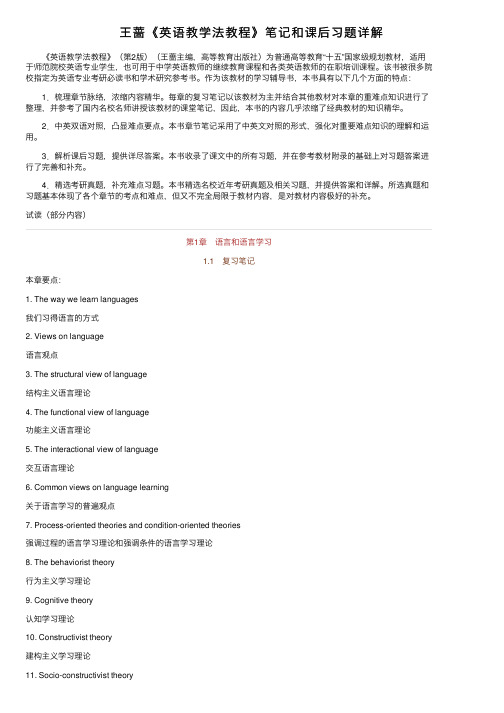
王蔷《英语教学法教程》笔记和课后习题详解《英语教学法教程》(第2版)(王蔷主编,⾼等教育出版社)为普通⾼等教育“⼗五”国家级规划教材,适⽤于师范院校英语专业学⽣,也可⽤于中学英语教师的继续教育课程和各类英语教师的在职培训课程。
该书被很多院校指定为英语专业考研必读书和学术研究参考书。
作为该教材的学习辅导书,本书具有以下⼏个⽅⾯的特点:1.梳理章节脉络,浓缩内容精华。
每章的复习笔记以该教材为主并结合其他教材对本章的重难点知识进⾏了整理,并参考了国内名校名师讲授该教材的课堂笔记,因此,本书的内容⼏乎浓缩了经典教材的知识精华。
2.中英双语对照,凸显难点要点。
本书章节笔记采⽤了中英⽂对照的形式,强化对重要难点知识的理解和运⽤。
3.解析课后习题,提供详尽答案。
本书收录了课⽂中的所有习题,并在参考教材附录的基础上对习题答案进⾏了完善和补充。
4.精选考研真题,补充难点习题。
本书精选名校近年考研真题及相关习题,并提供答案和详解。
所选真题和习题基本体现了各个章节的考点和难点,但⼜不完全局限于教材内容,是对教材内容极好的补充。
试读(部分内容)第1章 语⾔和语⾔学习1.1 复习笔记本章要点:1. The way we learn languages我们习得语⾔的⽅式2. Views on language语⾔观点3. The structural view of language结构主义语⾔理论4. The functional view of language功能主义语⾔理论5. The interactional view of language交互语⾔理论6. Common views on language learning关于语⾔学习的普遍观点7. Process-oriented theories and condition-oriented theories强调过程的语⾔学习理论和强调条件的语⾔学习理论8. The behaviorist theory⾏为主义学习理论9. Cognitive theory认知学习理论10. Constructivist theory建构主义学习理论11. Socio-constructivist theory社会建构主义理论12. Qualities of a good language teacher⼀个好的语⾔⽼师必备的素养13. Teacher’s professional development教师专业技能发展本章考点:我们如何习得语⾔;结构主义语⾔理论;功能主义语⾔理论;交互语⾔理论;关于语⾔学习的普遍观点;强调过程的语⾔学习理论和强调条件的语⾔学习理论;⾏为主义学习理论;认知学习理论;建构主义学习理论;社会建构主义理论;成为⼀个好的语⾔⽼师所要具备的基本素质;教师专业技能发展图。
王蔷《英语教学法教程》笔记和课后习题(含考研真题)详解(交际教学原则与任务型语言教学)【圣才出品】
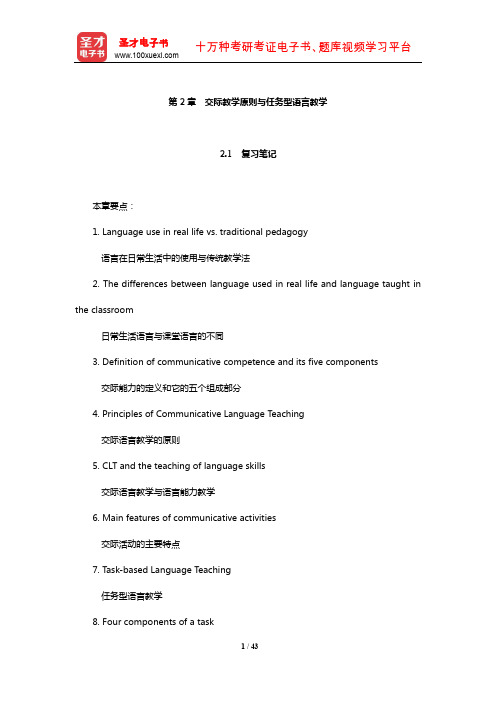
第2章交际教学原则与任务型语言教学2.1 复习笔记本章要点:1. Language use in real life vs. traditional pedagogy语言在日常生活中的使用与传统教学法2. The differences between language used in real life and language taught in the classroom日常生活语言与课堂语言的不同3. Definition of communicative competence and its five components交际能力的定义和它的五个组成部分4. Principles of Communicative Language Teaching交际语言教学的原则5. CLT and the teaching of language skills交际语言教学与语言能力教学6. Main features of communicative activities交际活动的主要特点7. T ask-based Language Teaching任务型语言教学8. Four components of a task任务的四个部分9. PPP and T ask-based Language Teaching介绍,练习和产出与任务型语言教学10. The steps to design tasks设计任务的步骤11. Appropriateness of CLT and TBLT in the Chinese context交际语言教学的恰当性和中文环境的任务型语言教学本章考点:语言在日常生活中的使用与传统教学法;日常生活语言与课堂语言的不同;交际能力的定义和它的五个组成部分;交际语言教学的原则;交际语言教学与语言能力教学;交际活动的主要特点;任务型语言教学;任务的四个部分;介绍,练习和产出与任务型语言教学的不同;设计任务的步骤;交际语言教学的恰当性和中文环境的任务型语言教学。
王蔷《英语教学法教程》笔记和课后习题(含考研真题)详解(英语教育资源的开发与利用)【圣才出品】
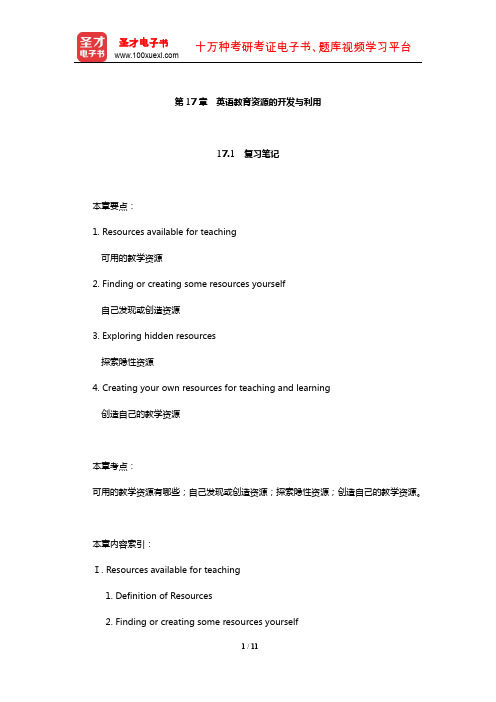
第17章英语教育资源的开发与利用17.1 复习笔记本章要点:1. Resources available for teaching可用的教学资源2. Finding or creating some resources yourself自己发现或创造资源3. Exploring hidden resources探索隐性资源4. Creating your own resources for teaching and learning创造自己的教学资源本章考点:可用的教学资源有哪些;自己发现或创造资源;探索隐性资源;创造自己的教学资源。
本章内容索引:Ⅰ. Resources available for teaching1. Definition of Resources2. Finding or creating some resources yourselfⅡ. Exploring hidden resourcesⅢ. ConclusionⅠ.Rsources available for teaching(可用的教学资源)1. Definition of Resources(教学资源的定义)It refers to books, any person, animals, or any object, that make teaching and learning easier, clearer and more interesting. Obviously, in teaching English, we will need different kinds of resources to make our teaching more effective. Some publishers nowadays provide teachers with a package of materials which include flashcards, pictures, storybooks, tapes or CD-ROMs.教学资源主要包括课本、人、动物以及任何让教学更简单、更清晰、更有趣的物体。
王蔷《英语教学法教程》笔记和课后习题(含考研真题)详解(综合技能)【圣才出品】
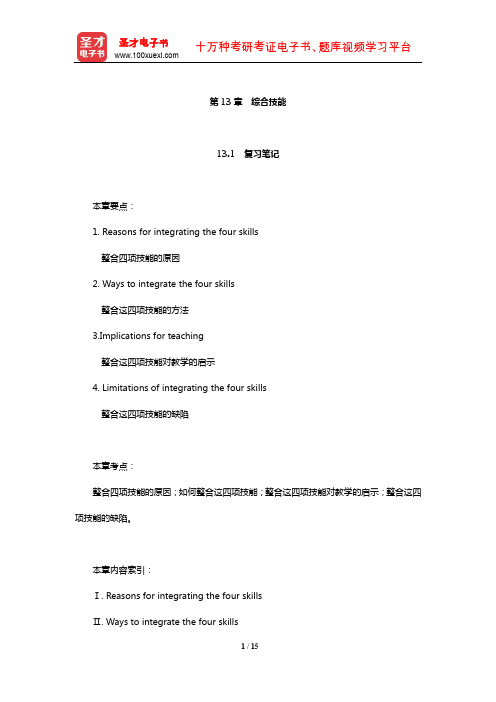
第13章综合技能13.1 复习笔记本章要点:1. Reasons for integrating the four skills整合四项技能的原因2. Ways to integrate the four skills整合这四项技能的方法3.Implications for teaching整合这四项技能对教学的启示4. Limitations of integrating the four skills整合这四项技能的缺陷本章考点:整合四项技能的原因;如何整合这四项技能;整合这四项技能对教学的启示;整合这四项技能的缺陷。
本章内容索引:Ⅰ. Reasons for integrating the four skillsⅡ. Ways to integrate the four skillsⅢ. Implications for teaching1. Focus on discourse2. Adjusting the textbook contents3. Adjusting the timetableⅣ. Limitations of integrating the four skillsⅤ. ConclusionⅠ. Reasons for integrating the four skills|(整合四项技能的原因)【考点:整合四项技能的原因】In our daily lives, we are constantly performing tasks that involve a natural integration of language skills simply because skills are rarely used in isolation. One’s overall competence in a foreign language involves performing effectively a combination of the skills.我们在现实生活中完成的任务需要综合四项技能。
王蔷《英语教学法教程》笔记和课后习题(含考研真题)详解(口语教学)【圣才出品】

第10章口语教学10.1 复习笔记本章要点:1. Characteristics of spoken language口语的特点2. Four common features of spoken language口语的四个共同特征3. Activities help prepare students for real-life speech in English 为学生做好日常口语准备的活动4. General principles of teaching speaking口语教学的普遍原则5. Two factors considered in designing speaking tasks设计口语任务要考虑的两个因素6. Common characteristics in successful speaking task成功的口语任务的共性7. Two types of communicative speaking activities两种不同类型的交际口语活动8. Some kinds of speaking activities几种不同类型的口语活动9. Advantages of using group in speaking tasks使用分组教学的优势本章考点:口语的特点及对教学的暗示;口语的四个共同特征;为学生做好日常口语准备的活动;口语教学的普遍原则;设计口语任务要考虑的两个因素;成功的口语任务的共性;两种不同类型的交际口语活动;几种不同类型的口语活动;使用分组教学的优势。
本章内容索引:Ⅰ. Differences between spoken and written language1. Characteristics of spoken language2. Four common features of spoken language3. Activities helpful to prepare students for real-life speech in English4. Some implications to teachingⅡ. Principles for teaching speakingⅢ. Designing speaking tasks1. Two factors considered in designing speaking tasks2. Common characteristics in successful speaking tasksⅣ.Types of speaking tasks1. Two major purposes for listening2. Two types of communicative speaking activities3. Some kinds of speaking activities4. Other speaking activitiesⅤ.Organizing speaking tasksⅥ.ConclusionⅠ.Differences between spoken and written language (口语与书面语的区别)【考点:口语的特点及对教学的暗示】Speaking is a skill that the students will be judged upon most in real-life situations.口语是用来判断学生在实际生活中使用最多的技能。
王蔷《英语教学法教程》笔记和课后习题(含考研真题)详解(语音教学)【圣才出品】

第6章语音教学6.1 复习笔记本章要点:1. The role of pronunciation语音的角色2. Factors that determine whether students need to focus on pronunciation决定学生是否需要关注语音的因素3. Critical Period Hypothesis关键期假说4. The realistic goal of teaching pronunciation语音教学的实际目标5. Three aspects of pronunciation to teach语音教学的三个方面6. Focusing on a sound; Perception practice; Production practice单音练习; 知觉/领会性练习; 生成性练习7. Practicing stress and intonation 练习重音和语调本章考点:语音的作用;决定学生是否需要关注语音的因素;关键期假说;决定学生流利语音的因素;语音教学的实际目标;语音教学的三个方面;单音练习;知觉/领会性练习;生成性练习;两种不同类型的重音;表示重音类型的三种方式。
本章内容索引:Ⅰ. The role of pronunciationⅡ. The goal of teaching pronunciation1. Critical Period Hypothesis2. Factors that determine if the students can aquire native-like English pronunciation3. The realistic goal of teaching pronunciationⅢ. Aspects of pronunciation1. Three aspects of pronunciation to teach2. One common problem in learning pronunciationⅣ. Practicing sounds1. Focusing on a sound2. Perception practice3. Production practiceⅤ. Practicing stress and intonation1. Practicing stress2. Practicing intonationⅥ. ConclusionⅠ. The role of pronunciation(语音的作用)【考点:语音的作用;决定学生是否需要关注语音的因素】Whether pronunciation needs special attention or focus in language teaching depends on many factors, especially learner factors.语言教学中是否需要特别关注语音取决于许多因素,尤其是学习者因素。
王蔷《英语教学法教程》笔记和课后习题(含考研真题)详解(词汇教学)【圣才出品】

第8章词汇教学8.1 复习笔记本章要点:1. The role of vocabulary uncertainty词汇的不确定性因素2. About knowing a word学习词汇应该包含的内容3. Understanding of its denotative and connotative meaning; 理解其外延意义和内涵意义4. Understanding the sense relations among words理解词汇间的语义关系5. Receptive and productive vocabulary接受性词汇和产出性词汇6. Ways of presenting vocabulary讲授词汇的方法7. Things a teacher does after presentation教师讲完词汇后应该做什么8. Ways of consolidating vocabulary巩固词汇的方法9. Developing vocabulary learning strategies发展词汇学习策略本章考点:理解词汇和词汇学习;词汇的不确定性因素;学习词汇应该包含的内容;词汇的学习;接受性词汇和产出性词汇;讲授词汇的方法;教师讲完词汇后应该做什么;巩固词汇的方法;词汇学习的策略。
本章内容索引:Ⅰ. Understanding vocabulary and vocabulary learningⅡ. About knowing a word1. Knowing a word2. Vocabulary learningⅢ. Ways of presenting vocabulary1. The methods to present and explain vocabulary2. Things a teacher does after presentationⅣ. Ways of consolidating vocabularyⅤ. Developing vocabulary learning strategies1. Review regularly2. Guess meaning from context3. Organize vocabulary effectively4. Use a dictionary5. Manage strategy useⅥ. ConclusionⅠ. Understanding vocabulary and vocabulary learning (理解词汇和词汇学习)【考点:理解词汇和词汇学习;词汇的不确定性因素】The role of vocabulary seems to have received more consistent understanding.大家对词汇的角色的认识基本上是一致的。
王蔷《英语教学法教程》笔记和课后习题(含考研真题)详解-第7~10章【圣才出品】
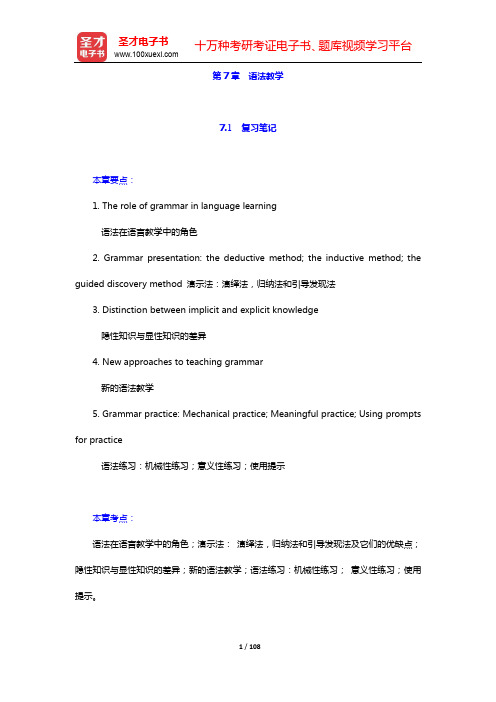
第7章语法教学7.1 复习笔记本章要点:1. The role of grammar in language learning语法在语言教学中的角色2. Grammar presentation: the deductive method; the inductive method; the guided discovery method 演示法:演绎法,归纳法和引导发现法3. Distinction between implicit and explicit knowledge隐性知识与显性知识的差异4. New approaches to teaching grammar新的语法教学5. Grammar practice: Mechanical practice; Meaningful practice; Using prompts for practice语法练习:机械性练习;意义性练习;使用提示本章考点:语法在语言教学中的角色;演示法:演绎法,归纳法和引导发现法及它们的优缺点;隐性知识与显性知识的差异;新的语法教学;语法练习:机械性练习;意义性练习;使用提示。
本章内容索引:Ⅰ. The role of grammar in language learningⅡ. Grammar presentation1. The deductive method2. The inductive method3. The guided discovery method4. Distinction between implicit and explicit knowledge5. New approaches to teaching grammarⅢ. Grammar practice1. Mechanical practice2. Meaningful practice3. Using prompts for practiceⅣ. ConclusionⅠ. The role of grammar in language learning(语法在语言教学中的角色)【考点:语法在语言教学中的角色】Despite many different views about the role of grammar in language learning, the importance of grammar cannot be denied. Grammatical competence is essential for communication.人们对语法在外语教学中的价值众说纷纭,意见不一,尽管如此,语法的重要性是不言而喻的。
王蔷《英语教学法教程》笔记和课后习题(含考研真题)详解-第1~3章【圣才出品】
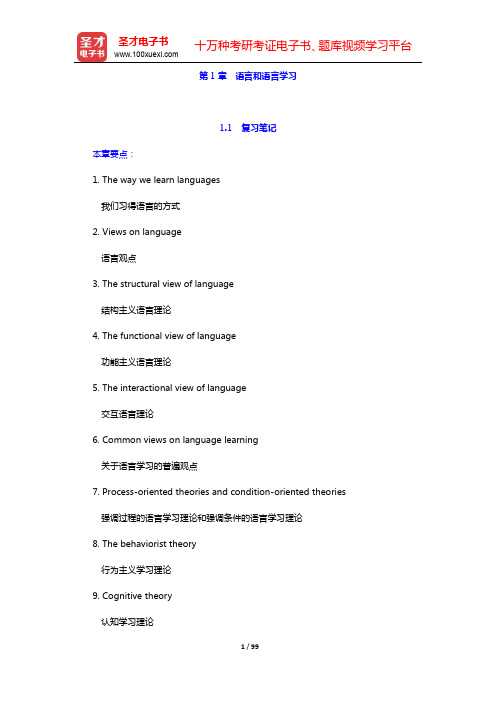
第1章语言和语言学习1.1 复习笔记本章要点:1. The way we learn languages我们习得语言的方式2. Views on language语言观点3. The structural view of language结构主义语言理论4. The functional view of language功能主义语言理论5. The interactional view of language交互语言理论6. Common views on language learning关于语言学习的普遍观点7. Process-oriented theories and condition-oriented theories 强调过程的语言学习理论和强调条件的语言学习理论8. The behaviorist theory行为主义学习理论9. Cognitive theory认知学习理论10. Constructivist theory建构主义学习理论11. Socio-constructivist theory社会建构主义理论12. Qualities of a good language teacher一个好的语言老师必备的素养13. Teacher’s professional development教师专业技能发展本章考点:我们如何习得语言;结构主义语言理论;功能主义语言理论;交互语言理论;关于语言学习的普遍观点;强调过程的语言学习理论和强调条件的语言学习理论;行为主义学习理论;认知学习理论;建构主义学习理论;社会建构主义理论;成为一个好的语言老师所要具备的基本素质;教师专业技能发展图。
本章内容索引:Ⅰ. The way we learn languagesⅡ. Views on language1. The structural view of language2. The functional view of language3. The interactional view of languageⅢ. Views on language learning and learning in general1. Research on language learning2. Common views on language learning and learning in general(1)Behaviorist theory(2)Cognitive theory(3)Constructivist theory(4)Socio-constructivist theoryⅣ. Qualities of a good language teacherⅤ. Development of a good language teacherⅥ. An overview of the bookThis chapter serves as an introduction for setting the scene for this methodology course. It discusses issues concerning views on language and language learning or learning in general with the belief that such views will affect teachers’ ways of teaching and thus learners’ ways of learning. The qualities of a good language teacher are also discussed in order to raise the participants’ awareness of what is required for a good English teacher.这一章主要是介绍教学法的方法论,其中讨论的问题涉及语言和语言学习的观点,或者一般学习及这些观点对教师教学方式和学习者学习方式的影响,本章也讨论了一个好的英语教师应具备的素质,以提高语言教学参与者对优秀英语教师相关要求的意识。
王蔷《英语教学法教程》笔记和课后习题(含考研真题)详解(学习者个体差异与学习策略培养)【圣才】
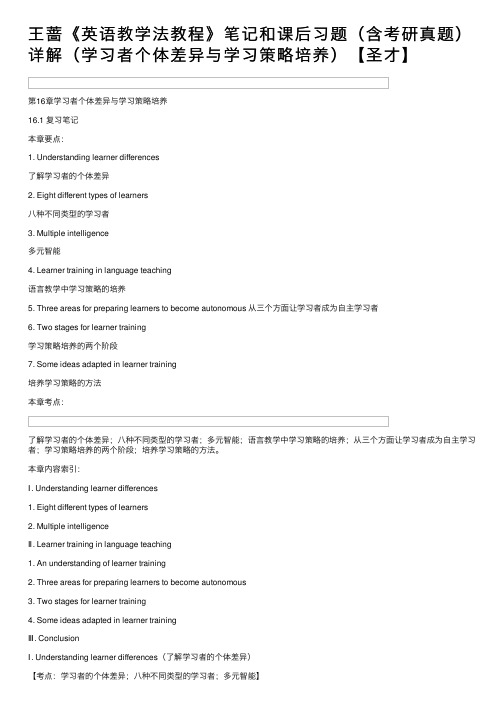
王蔷《英语教学法教程》笔记和课后习题(含考研真题)详解(学习者个体差异与学习策略培养)【圣才】第16章学习者个体差异与学习策略培养16.1 复习笔记本章要点:1. Understanding learner differences了解学习者的个体差异2. Eight different types of learners⼋种不同类型的学习者3. Multiple intelligence多元智能4. Learner training in language teaching语⾔教学中学习策略的培养5. Three areas for preparing learners to become autonomous 从三个⽅⾯让学习者成为⾃主学习者6. Two stages for learner training学习策略培养的两个阶段7. Some ideas adapted in learner training培养学习策略的⽅法本章考点:了解学习者的个体差异;⼋种不同类型的学习者;多元智能;语⾔教学中学习策略的培养;从三个⽅⾯让学习者成为⾃主学习者;学习策略培养的两个阶段;培养学习策略的⽅法。
本章内容索引:Ⅰ. Understanding learner differences1. Eight different types of learners2. Multiple intelligenceⅡ. Learner training in language teaching1. An understanding of learner training2. Three areas for preparing learners to become autonomous3. Two stages for learner training4. Some ideas adapted in learner trainingⅢ. ConclusionⅠ. Understanding learner differences(了解学习者的个体差异)【考点:学习者的个体差异;⼋种不同类型的学习者;多元智能】People learn in different ways. Some people learn better from seeing things and using diagrams while other people enjoy reading and writing more than seeing movies or watching television. Different people have different learning styles.⼈们的学习⽅式不同,⼀些⼈通过观察事物和图表获得更好的学习体验,⽽其他⼈⽐起看电影或电视则更喜欢阅读、写作。
王蔷《英语教学法教程》笔记和课后习题(含考研真题)详解(国家英语课程标准)【圣才出品】

第3章国家英语课程标准3.1 复习笔记本章要点:1. Syllabus and curriculum教学大纲和课程设置2. A brief history of foreign language teaching in China中国外语教学简史3. Designing principles for the National English Curriculum国家英语课程设置原则4. Goals and objectives of English language teaching英语语言教学的目标5. Design of the National English Curriculum国家英语课程的设置6. Challenges facing English language teachers英语语言教师所面临的挑战本章考点:教学大纲和课程设置;中国外语教学简史;国家英语课程设置原则;英语语言教学的目标;英语语言教师所面临的挑战和解决办法。
本章内容索引:Ⅰ. A brief history of foreign language teaching in China1. The differences between syllabus and curriculum2. Foreign language teaching in ChinaⅡ. Designing principles for the National English CurriculumⅢ. Goals and objectives of English language teachingⅣ. Design of the National English CurriculumⅤ. Performance standards for different levels of competenceⅥ. Challenges facing English language teachersⅦ. ConclusionⅠ. A brief history of foreign language teaching in China(中国外语教学简史)1. The differences between syllabus and curriculum教学大纲和课程设置的不同A syllabus is a specification of what takes place in the classroom, which usually contains the aims and contents of teaching and sometimes contains suggestions of methodology.教学大纲具体规定了课堂教学内容,通常包括对于教学目标和教学内容,有时还包括教学方法的建议。
王蔷《英语教学法教程》笔记和课后习题(含考研真题)详解(阅读教学)【圣才出品】

第11章阅读教学11.1 复习笔记本章要点:1. Reading aloud and silent reading朗读和默读2. Features of effective readers有效率的读者的特征3. Strategies involved in reading comprehension 阅读理解策略4. Two broad levels in reading两种阅读水平5. The role of vocabulary in reading词汇在阅读中的作用6. Sight vocabulary视觉词汇7. Three models of teaching reading三种阅读教学模式8. Three stages involved in T eaching Reading阅读教学的三个阶段9. Pre-reading activities读前活动10. While-reading activities读中活动11. Purposes of transition device转换手法的目的12. The classification of Reading comprehension questions阅读理解题的分类13. Types of post-reading activities读后活动类型本章考点:朗读和默读;有效率的读者的特征;阅读理解策略;两种阅读水平;词汇在阅读中的作用;视觉词汇;三种阅读教学模式;阅读教学的三个阶段;读前活动;读中活动;转换手法的目的;阅读理解题的分类;读后活动类型。
本章内容索引:Ⅰ. Reflecting on your own reading experiencesⅡ. The way of reading1. Reading aloud and silent reading2. Features of effective readersⅢ. The content of readingⅣ. Strategies involved in reading comprehension1. Definition of reading2. Two broad levels in readingⅤ. The role of vocabulary in reading1. The importance of vocabulary2. Sight vocabularyⅥ. Principles and models for teaching reading1. Three models of teaching reading2. Three stages involved in teaching reading Ⅶ. Pre-reading activities1. Definition of pre-reading activities2. Predicting3. Setting the scene4. Skimming5. Scanning6. Summary on pre-reading activitiesⅧ. While-reading activities1. Information transfer2. Purposes of transition device3. Reading comprehension questions4. Understanding references5. Making inferences6. Summary on while-reading activitiesⅨ. Post-reading activities1. Objectives2. Requirements3. Types of post-reading activitiesⅩ. ConclusionⅠ. Reflecting on your own reading experiences (反思自己的阅读经验)All of us began reading in our first language at a very early age and we all have experiences of being influenced by certain authors or particular books.我们在很小的时候开始用母语阅读了,我们都受到某些作者或书籍的影响。
王蔷《英语教学法教程》知识点单元重点归纳
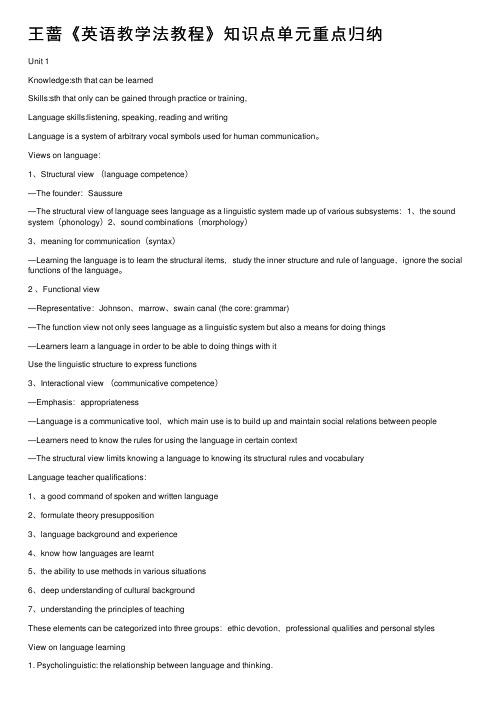
王蔷《英语教学法教程》知识点单元重点归纳Unit 1Knowledge:sth that can be learnedSkills:sth that only can be gained through practice or training,Language skills:listening, speaking, reading and writingLanguage is a system of arbitrary vocal symbols used for human communication。
Views on language:1、Structural view (language competence)—The founder:Saussure—The structural view of language sees language as a linguistic system made up of various subsystems:1、the sound system(phonology)2、sound combinations(morphology)3、meaning for communication(syntax)—Learning the language is to learn the structural items,study the inner structure and rule of language,ignore the social functions of the language。
2 、Functional view—Representative:Johnson、marrow、swain canal (the core: grammar)—The function view not only sees language as a linguistic system but also a means for doing things—Learners learn a language in order to be able to doing things with itUse the linguistic structure to express functions3、Interactional view (communicative competence)—Emphasis:appropriateness—Language is a communicative tool,which main use is to build up and maintain social relations between people —Learners need to know the rules for using the language in certain context—The structural view limits knowing a language to knowing its structural rules and vocabularyLanguage teacher qualifications:1、a good command of spoken and written language2、formulate theory presupposition3、language background and experience4、know how languages are learnt5、the ability to use methods in various situations6、deep understanding of cultural background7、understanding the principles of teachingThese elements can be categorized into three groups:ethic devotion,professional qualities and personal stylesView on language learning1. Psycholinguistic: the relationship between language and thinking.1)Thinking in language2)Language is necessary for thought.3)Language acquisition(语⾔习得)4)Learners in their earlier years acquire control over essential structure of their languagewithout special teaching and learning in a effortless and almost an unconscious way (like the formation of a habit) people prefer first language acquisition to first language learning.2.Cognitive theory: the rule for people to aware to cognize sth.Cognitive processes:Process: input----absorb----outputLanguage learning is not just stimulate-reflection, but the using of oursubjective capabilities, the using of our cognitive ability to think the language and studying it actively.3. Constructivist theory: learning is a process of meaning construction based on learner?s own knowledge and experience. S ----------AT------------R(刺激) (反应)Stimulus: assimilatio n ①and accommodatio n②①把外部知识纳⼊⾃⾝②纳⼊⾃⾝后也不相符,就要对原有知识进⾏改变,也就是⼀种原有知道和外部知识保持联系的创新的过程。
王蔷《英语教学法教程》笔记和课后习题(含考研真题)详解(教学评价)【圣才出品】

第15章教学评价15.1 复习笔记本章要点:1. The differences between testing, assessment and evaluation 测试、评价和评估的区别2. Assessment purposes评价目的3. Methods for assessment评价方法4. The ways to gather students learning information收集学生学习信息的方法5. Different criteria or references of assessment评价的不同标准或参考6. Criteria to assess portfolios评估学生档案的原则7. Assessment principles评价原则8. Drawbacks of using tests for assessment测试评价的缺点9. T est items can be designed in various formats不同形式的测试项目本章考点:测试、评价和评估的区别;评价目的;评价方法;收集学生学习信息的方法;评价的不同标准或参考;如何评估学生档案;评价原则;测试评价的缺点;不同形式的测试项目。
本章内容索引:Ⅰ. Understanding assessmentⅡ. Assessment purposes1. For administrators2. For teachers3. For parents4. For studentsⅢ. Methods for assessment1. Summative assessment2. Formative assessment3. The ways to gather students’learning informationⅣ. Criteria for assessment1. Different criteria or references of assessment2. Criteria to assess portfoliosⅤ. Assessment principlesⅥ. T ests in assessment1. Drawbacks of using tests for assessment2. Test itemsⅦ. ConclusionⅠ. Understanding assessment(理解评价)【考点:测试、评价和评估的区别】The differences between testing, assessment and evaluation:测试、评价和评估的区别:Testing: It often takes the ‘pencil and paper’form and it is usually done at the end of a learning period, such as unit-test, mid-term-test, semester-test etc.测试:通常是“笔纸”形式,通常发生在一个学习阶段末尾,如单元测试、期中测试和期末测试等。
王蔷《英语教学法教程》笔记和课后习题(含考研真题)详解(语言教学中的德育教育)【圣才出品】
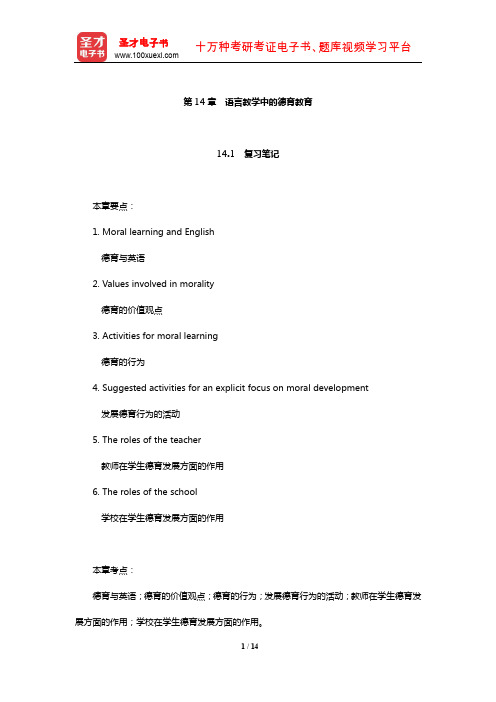
第14章语言教学中的德育教育14.1 复习笔记本章要点:1. Moral learning and English德育与英语2. Values involved in morality德育的价值观点3. Activities for moral learning德育的行为4. Suggested activities for an explicit focus on moral development发展德育行为的活动5. The roles of the teacher教师在学生德育发展方面的作用6. The roles of the school学校在学生德育发展方面的作用本章考点:德育与英语;德育的价值观点;德育的行为;发展德育行为的活动;教师在学生德育发展方面的作用;学校在学生德育发展方面的作用。
本章内容索引:Ⅰ. Moral learning and English1. Moral learning in English teaching2. Values involved in moralityⅡ. Activities for moral learningⅢ. The roles of the teacher1. T eacher as role model2. T eacher as curriculum developerⅣ. The roles of the schoolⅤ. ConclusionⅠ. Moral learning and English(德育与英语)【考点:德育与英语的关系;德育包含的价值观点】1. Moral learning in English teaching(英语教学中的德育)Teachers are not just responsible for students’intellectual or physical development; teachers are also responsible for students’moral development.教师不仅对学生的智力或身体发展负责,还对其道德发展负责。
王蔷《英语教学法教程》笔记和课后习题(含考研真题)详解(教案设计与书写)【圣才出品】
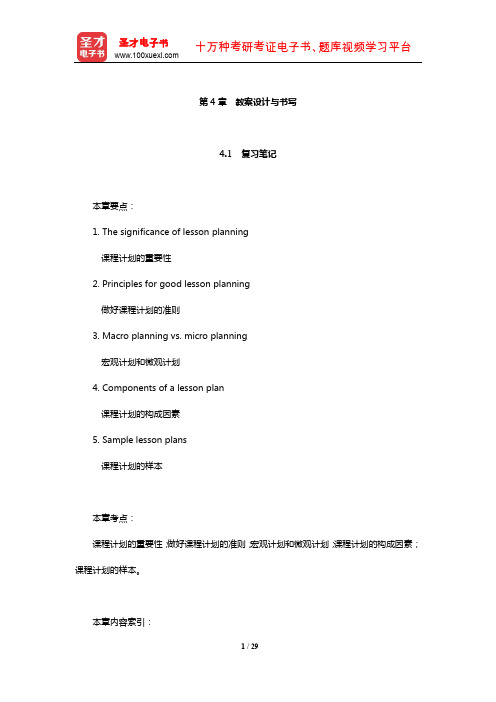
第4章教案设计与书写4.1 复习笔记本章要点:1. The significance of lesson planning课程计划的重要性2. Principles for good lesson planning做好课程计划的准则3. Macro planning vs. micro planning宏观计划和微观计划4. Components of a lesson plan课程计划的构成因素5. Sample lesson plans课程计划的样本本章考点:课程计划的重要性;做好课程计划的准则;宏观计划和微观计划;课程计划的构成因素;课程计划的样本。
本章内容索引:Ⅰ. The significance of lesson planning1. Definition of lesson planning2.The necessity of lesson planning for teachers3. Benefits of lesson planningⅡ. Principles for good lesson planningⅢ. Macro planning vs. micro planning1. Two levels of lesson planning2. The advantage of a concrete teaching planⅣ. Components of a lesson plan1. Background information2. T eaching aims3. Language contents and skills4. Stages and procedures5. T eaching aids6. End of lesson summary7. Optional activities and assignments8. After lesson reflectionⅤ. Sample lesson plansⅥ. ConclusionⅠ. The significance of lesson planning(课程计划的重要意义)1. Definition of lesson planning课程计划的定义Lesson planning means making decisions in advance about what techniques, activities and materials will be used in the class.课程计划就是提前决定在课堂上使用什么技巧、材料、进行什么活动。
英语教学法教程第二版(王蔷)1-5单元学习笔记
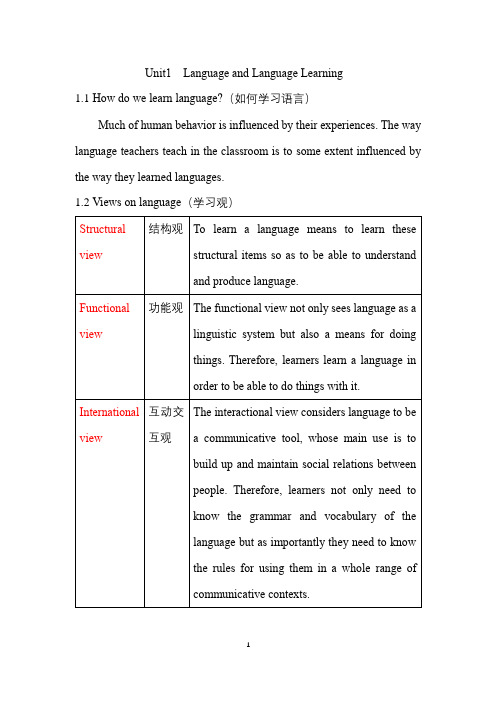
Unit1 Language and Language Learning1.1How do we learn language?(如何学习语言)Much of human behavior is influenced by their experiences. The way language teachers teach in the classroom is to some extent influenced by the way they learned languages.1.2Views on language(学习观)1.3Views on language learning and learning in generalNow, the research about language learning theories can be broadly divided into two parts. They are Process-oriented theories and Condition-oriented theories. Some researchers attempt to formulate teaching approaches directly from these theories. For example, the Natural Approach, Total physical Response, and the Silent Way are based on one or more dimensions of processes and conditions. Here are What is done in these processes.1.4What makes a good language teacher?(好教师的素质要素)①Ethic devotion ②Professional qualities ③Personal styles1.5How can we become a good language teacher?(如何成为一名好的语言老师)The most important and difficult part of the making of a good language teacher is the development of professional competence, which is the state or quality of being adequately qualified for the profession, and armed with a specific range of skills, strategies, knowledge, and ability.Teacher’s professional development1.6An overview of the bookUnit2 Communication Principles and Task-based Language Teaching 2.1 Language use in real life vs. traditional pedagogy2.2 What is communicative competence?communicative competence includes both the knowledge about the language and the knowledge about how to use the language appropriately in communicative situation.2.3 Implications for teaching and learning (略)2.4 Principles of Communicative Language Teaching(CLT)1)Communication principle: Activities that involves real communication promote learning.2) Task principle: Activities in which language is used for carry out meaningful tasks promote learning.3) Meaningfulness principle: Language that is meaningful to the learner supports the learning process.2.5 CLT and the teaching of language skills2.6 Main features of Communicative activities2.7 Task-based Language Teaching(TBLT)Task-based Language Teaching is, in fact, a further development of Communicative Language Teaching.2.7.1 Definitions of a task√√2.7.2 Four components of a task.1) A purpose: making sure the students have a reason for undertaking the task.2) A context: this can be real, simulated, or imaginary, and involves sociolinguistic issues such as the location, the participants and their relationship, the time, and other important factors.3) A process: getting the students to use learning strategies such as problemsolving, reasoning, inquiring, conceptualizing and communicating.4) A product: there well be some form of outcome, either visible(written plan, a play, a letter, etc.) or invisible (enjoying a story, learning about another country, etc.)2.7.3 Exercises, exercise-tasks and taskexercise exercise-task task2.8 PPP and Task-based Language TeachingMany teachers may be familiar with the Presentation, Practice and Production(PPP). A typical PPP lesson would start by the teacher introducing a new language item in a context followed by some controlled practice, such as drilling, repetition, dialogue reading, etc. Students then move on to produce the language in a more meaningful way, such as a role play, a drama, an interview, etc. Some teachers may also be familiar with the five-step teaching method, which is quite similar to the PPP model but adding revision at the beginning and consolidation at the end.2.8.1 Differences between PPP and TBL1) The way students use and experience language in TBL is rapidly different from PPP.2) TBL can provide a context for grammar teaching and form-focused activities. PPP is different in this aspect.2.9 How to design tasks?√√2.10 Appropriateness of CLT and TBLT in the Chinese context1)The problems of CLT: ①If CLT is culturally appropriate.(Both its advantages and constraints are recognized by teachers and students.)②It is very difficult to design a syllabus with a one to one correspondence between a function and a form.2)The problems of TBLT: ①It may not be effective for presenting new language items.(Swan,2005) ②Time. Teachers have to prepare task-based activities very carefully. ③The culture of learning. Some students may find it difficult to adapt to TBLT. ④The level of difficulty. Students mayfind task-based learning quite difficult if they do not have sufficient linguistic resources to handle holistic communication.2.11 ConclusionIt is important to remember that a method is effective only when it is appropriate to the teaching context. Therefore, when a new method or approach emerges, it is unwise to simply cast away the traditional and follow the new trend. The best thing to do is to develop one’s own teaching methods based on the context where one teaches and integrates the merits of different methodologies to serve the purpose of one’s teaching objectives and the needs of one’s students.Unit3 The National English Curriculum3.1 A brief history of foreign language teaching in ChinaUnit4 Lesson Planning4.1 Why is lesson planning important?Definition: A lesson plan is a framework of a lesson in which teachers make advance decisions about what they hope to achieve and how they would like to achieve it.Reasons: ①A clear lesson plan makes the teacher aware of the aims and language contents of the lesson.②It helps teachers distinguish thevarious stages of a lesson and see the relationship between them so that the activities of different difficulty levels can be arranged properly and the lesson can move smoothly from one stage to another.③Proper lesson planning gives teachers the opportunity to anticipate potential problems that may arise in class so that they can be prepared with some possible solutions or other options for the lesson. ④Good planning gives teachers, especially novice teachers confidence in class. ⑤When planning the lesson, the teacher also becomes aware of the teaching aids that are needed for the lesson.⑥Planning is a good practice and a sign of professionalism.4.2 Principles for good lesson planning4.3 Macro planning vs. micro planning.(宏观计划vs.微观计划)The components of macro planning:(宏观计划包含的内容)1)Knowing about the profession.2)Knowing about the institution.3)Knowing about the learners.4)Knowing about the curriculum/syllabus.5)Knowing about the textbook.6)Knowing about the objectives.4.4 Components of a lesson planDifferent teachers have different teaching styles and may use different teaching procedures, so ‘every lesson is unique’(Robertson and Acklam,2000:6), and so is every lesson plan. A lesson plan include many parts.Unit5 Classroom ManagementDefinition:Classroom management is the way teachers organize what goes on in the classroom.Goal:To create an atmosphere conductive to interacting in English in meaningful ways.(Gebhard,1996)Conditions for achieving classroom management:1)The teacher plays appropriate roles.2)The teacher provides clear instructions.3)Students are grouped in a way suitable for the learning activities.4)The teacher asks appropriate questions.5)There is discipline as well as harmony in the class.6)The students errors are treated properly.5.1 The role of the teacherWhat are the teacher’s roles defined by Harmer?①controller ②assessor ③organiser ④prompter ⑤participant⑥resource-providerWhat are teacher’s new roles?①facilitators ②guides ③researchers5.2 Classroom instructionsDefinition: Classroom instructions refer to the type of language teachers use to organize or guide learning. They include giving directions to tasks or activities; providing explanations to a concept or language structure; setting requirements; checking comprehension; drawing attention; motivating learners; giving feedback and assigning homework, etc. Generally they include all classroom language that teachers may use for teaching purposes as well as for managing teaching.What are rules to follow for making instructions effective?①To use simple instructions and make them suit the comprehensionlevel of the students.②To use the mother-tongue only when it is necessary.③To be careful not to do all the talking in class.。
王蔷《英语教学法教程》笔记和课后习题(含考研真题)详解(语法教学)【圣才出品】
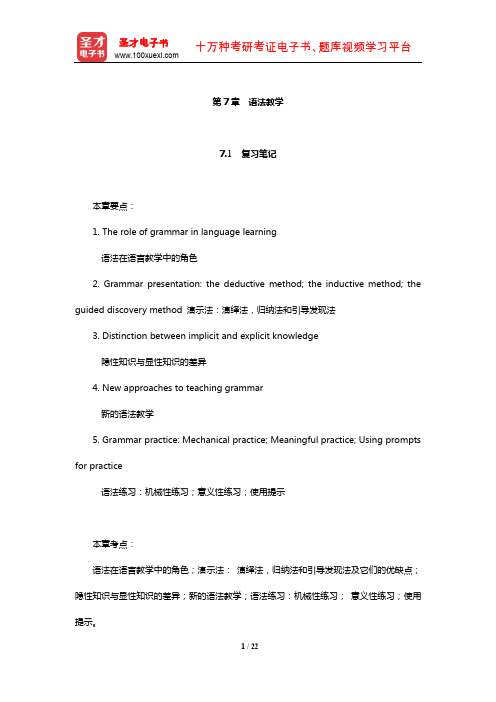
第7章语法教学7.1 复习笔记本章要点:1. The role of grammar in language learning语法在语言教学中的角色2. Grammar presentation: the deductive method; the inductive method; the guided discovery method 演示法:演绎法,归纳法和引导发现法3. Distinction between implicit and explicit knowledge隐性知识与显性知识的差异4. New approaches to teaching grammar新的语法教学5. Grammar practice: Mechanical practice; Meaningful practice; Using prompts for practice语法练习:机械性练习;意义性练习;使用提示本章考点:语法在语言教学中的角色;演示法:演绎法,归纳法和引导发现法及它们的优缺点;隐性知识与显性知识的差异;新的语法教学;语法练习:机械性练习;意义性练习;使用提示。
本章内容索引:Ⅰ. The role of grammar in language learningⅡ. Grammar presentation1. The deductive method2. The inductive method3. The guided discovery method4. Distinction between implicit and explicit knowledge5. New approaches to teaching grammarⅢ. Grammar practice1. Mechanical practice2. Meaningful practice3. Using prompts for practiceⅣ. ConclusionⅠ. The role of grammar in language learning(语法在语言教学中的角色)【考点:语法在语言教学中的角色】Despite many different views about the role of grammar in language learning, the importance of grammar cannot be denied. Grammatical competence is essential for communication.人们对语法在外语教学中的价值众说纷纭,意见不一,尽管如此,语法的重要性是不言而喻的。
